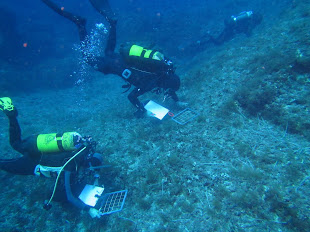Long term monitoring of biological and ecological parameters is an essential tool to evaluate alterations in the state of natural communities. This evaluation allows an adequate management of the evolution and threats of the natural communities to ensure their conservation.
The arrival of exotic species to areas outside their original range of distribution and their settlement in local ecosystems is one of the most important environmental problems affecting biodiversity. Colonization by these exotic species causes the displacement of native species and changes in the original ecosystem structures and functions. Marine coastal areas are places of high risk and vulnerability to the arrival of invasive species. In many cases, the increase in temperature due to climate change causes a displacement of species and favors their expansion in other habitats outside their original distribution. Establishing how climate change affects invasive species is very important to predict the impact caused on local marine ecosystems and communities.
This project continues to monitor different marine benthic communities influenced by the arrival of invasive algae, using genetic and ecological studies. An ecological monitoring of benthic communities began in 2005 in Cabrera Archipelago National Park and with this project we are extending the temporal frame of the time series to more than 15 years (2005-2021). To accompany the ecological monitoring we also continue to record environmental data (temperature) using continuous data loggers, with a time series started in 2007 to the present.
ECOLOGICAL STUDY AND METHODS
For the ecological study we visited 15 fixed stations that had been monitored since 2005. The exact knowledge of locations, habitats studied and methods used, allows us to obtain comparative data to analyze the dynamics of invasive species and their relationships with thermal variations in a long term time frame. The invasive species we are monitoring are Caulerpa cylindracea, Lophocladia lallemandii, Womersleyella setacea, Acrothamnion preissii, Asparagopsis taxiformis and Halimeda incrassata.
Communities with invasive species( Asparagopsis taxiformis, Lophocladia lallemadii and Halimeda incrassata)
The stations have been selected in order to cover a good representation of the great diversity of marine environments in the Park. Some of these stations are the same where community transects were performed in previous studies in the Park, which allows an accurate approximation to the possible changes occurring in the communities.
Bathymetric transects are carried out at each station to quantify the abundance, distribution and cover of invasive species in each of the communities. These bathymetric transects extend from near-surface in the upper infralittoral to distances located a few hundred meters from the coast or up to 40-50 meters deep.
 |
| Example of changes of the abundance in deph of Caulerpa cylindracea betwee 2017 and 2020. |
The limits of each different habitat that appears are noted throughout the entire transect. At the same time, the coverage of invasive algae present in each community is quantified. The estimation of invasive algae is performed using the abundance sampling method described in Ballesteros (1996). It is a direct and non-destructive in situ visual method, whose effectiveness compared to other methods has been demonstrated in recent studies. The method consists of counting the number of squares in which a species appears (presence) in a 25X25 cm square that contains 25 subdivisions of 5x5 cm squares. In our studies we toss 30 squares and count them per community.
Divers doing algae surveys using the subdivided square
During the sampling campaigns temperature sensors are replaced and the recorded data are read, incorporating the information to the existing database.
 |
| Temperature sections registered by the sensors collected in 2020. |
ECOLOGICAL MONITORING IN THE BIGPARK PROJECT
Members of the research team have been monitoring the abundance of invasive algae in the Cabrera Archipelago since 2005. This monitoring has been done within the framework of various projects of the OAPN (Autonomous National Park Organism) and the Biodiversity Foundation. Since 2007, continuous temperature sensors have been deployed along a depth gradient between 5 and 50 meters. The continuation of this historical and unique data series of temperature and abundance of invasive algae species in a large number of benthic habitats will allow us to establish possible relationships between climate change (specifically global warming) and the abundance of different invasive species in the Cabrera National Park.









